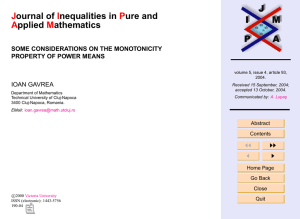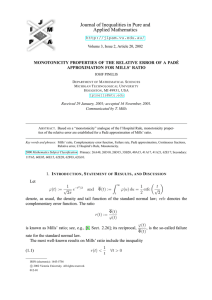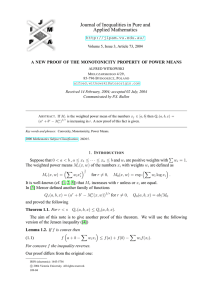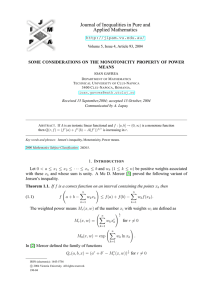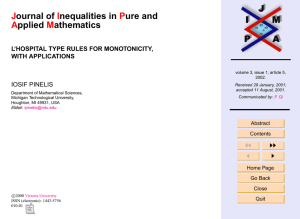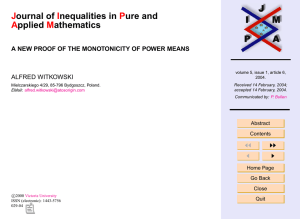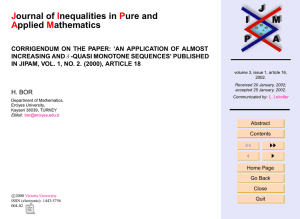J I P A
advertisement
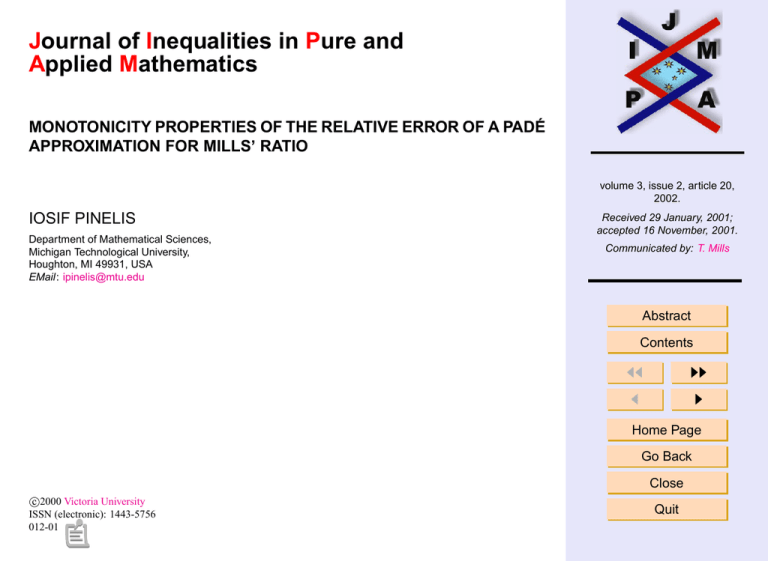
Journal of Inequalities in Pure and
Applied Mathematics
MONOTONICITY PROPERTIES OF THE RELATIVE ERROR OF A PADÉ
APPROXIMATION FOR MILLS’ RATIO
volume 3, issue 2, article 20,
2002.
IOSIF PINELIS
Department of Mathematical Sciences,
Michigan Technological University,
Houghton, MI 49931, USA
EMail: ipinelis@mtu.edu
Received 29 January, 2001;
accepted 16 November, 2001.
Communicated by: T. Mills
Abstract
Contents
JJ
J
II
I
Home Page
Go Back
Close
c
2000
Victoria University
ISSN (electronic): 1443-5756
012-01
Quit
Abstract
Based on a “monotonicity” analogue of the l’Hospital Rule, monotonicity properties of the relative error are established for a Padé approximation of Mills’
ratio.
2000 Mathematics Subject Classification: Primary: 26A48, 26D10, 26D15, 33B20,
40A15, 41A17, 41A21, 62E17; Secondary: 11Y65, 60E05, 60E15, 62E20, 62F03,
62G10
Key words: Mills’ ratio, Complementary error function, Failure rate, Padé approximation, Continuous fractions, Relative error, L’Hospital’s Rule, Monotonicity
Contents
1
Introduction, Statement of Results, and Discussion . . . . . . . . 3
2
Auxiliary Results . . . . . . . . . . . . . . . . . . . . . . . . . . . . . . . . . . . . . 11
3
Proofs of Main Results . . . . . . . . . . . . . . . . . . . . . . . . . . . . . . . . 14
References
Monotonicity Properties of the
Relative Error of a Padé
Approximation for Mills’ Ratio
Iosif Pinelis
Title Page
Contents
JJ
J
II
I
Go Back
Close
Quit
Page 2 of 19
J. Ineq. Pure and Appl. Math. 3(2) Art. 20, 2002
http://jipam.vu.edu.au
1.
Introduction, Statement of Results, and Discussion
Let
1
2
ϕ(t) := √ e−t /2
2π
Z
∞
and Φ(t) :=
t
1
ϕ(u) du = erfc
2
t
√
2
denote, as usual, the density and tail function of the standard normal law; erfc
denotes the complementary error function. The ratio
r(t) :=
Φ(t)
ϕ(t)
is known as Mills’ ratio; see, e.g., [6, Sect. 2.26]; its reciprocal,
Iosif Pinelis
ϕ(t)
, is the
Φ(t)
so-called failure rate for the standard normal law.
The most well-known results on Mills’ ratio include the inequality
(1.1)
1
r(t) <
t
∀t > 0
Title Page
Contents
JJ
J
II
I
Go Back
and the asymptotic relation
(1.2)
Monotonicity Properties of the
Relative Error of a Padé
Approximation for Mills’ Ratio
r(t) ∼
1
t
as t → ∞;
a
as usual, a ∼ b means → 1; cf., e.g., inequalities [6, Sect. 2.26, Eq. (1)] due
b
to Gordon [3] and the special case with p = 2 of inequalities [6, Section 2.26,
Eq. (7)] due to Gautschi [2].
Close
Quit
Page 3 of 19
J. Ineq. Pure and Appl. Math. 3(2) Art. 20, 2002
http://jipam.vu.edu.au
There are many different kinds of inequalities, as well as asymptotic and
numerical results, for Mills’ ratio in the literature. See e.g. [7, Chapter 3]
and references therein; in particular, a wealth of such information is given in
Shenton [12].
In this paper, we shall consider monotonicity properties of the relative error
(1.3)
δk (t) :=
r(t) − rk (t)
r(t)
for a sequence (rk (t)) of certain rational approximations of Mills’ ratio r(t); as
far as we know, such properties have not yet been considered. Such monotonicity properties may be used in an obvious manner: if it is known that |δk (t)| is
monotonically decreasing in t > 0 and |δk (t0 )| < δ for some t0 > 0 and δ > 0,
then |δk (t)| < δ for all t ∈ [t0 , ∞) – cf. Remark 1.1 below; also, if it is known
that, say, t2k |δk (t)| is monotonically increasing in t ∈ (0, ∞) from 0 to k!, then
k!
|δk (t)| < 2k for all t ∈ (0, ∞) – cf. part (ii) of Theorem 1.5.
t
Our main results here are based on the following “monotonicity” analogue
of the l’Hospital Rule, stated and proved in [8].
Theorem 1.1. Let f and g be differentiable functions on an interval (a, b) such
that f (a+) = g(a+) = 0 or f (b−) = g(b−) = 0, g 0 is nonzero and does not
f0
f
change sign, and 0 is increasing (decreasing) on (a, b). Then is increasing
g
g
(respectively, decreasing) on (a, b). (Note that the conditions here imply that g
is nonzero and does not change sign on (a, b).)
Further developments of Theorem 1.1 and other applications were given: in
[8], applications to certain information inequalities; in [9], extensions to non-
Monotonicity Properties of the
Relative Error of a Padé
Approximation for Mills’ Ratio
Iosif Pinelis
Title Page
Contents
JJ
J
II
I
Go Back
Close
Quit
Page 4 of 19
J. Ineq. Pure and Appl. Math. 3(2) Art. 20, 2002
http://jipam.vu.edu.au
monotonic ratios of functions, with applications to certain probability inequalities arising in bioequivalence studies and to problems of convexity; in [10],
applications to probability inequalities for sums of bounded random variables.
To begin the discussion here, let us illustrate possible applications of Theorem 1.1 with the following simple refinement of (1.1) and (1.2):
r(t)
is increasing in t ∈ (0, ∞) from 0 to 1, and so,
1/t
1/t − r(t)
is decreasing in t ∈ (0, ∞) from ∞ to 0.
the relative absolute error
r(t)
Proposition 1.2. The ratio
This proposition is immediate from Theorem 1.1 and the usual l’Hospital
Φ(t)
r(t)
and
rule for limits, because for t > 0 one has
=
ϕ(t)/t
1/t
Monotonicity Properties of the
Relative Error of a Padé
Approximation for Mills’ Ratio
Iosif Pinelis
Title Page
Φ(t)0
1
,
0 =
1 + 1/t2
(ϕ(t)/t)
Contents
which is increasing in t ∈ (0, ∞) from 0 to 1.
It is not hard to obtain the following generalization of (1.1) and (1.2).
JJ
J
II
I
Go Back
Proposition 1.3. For all k ∈ {0, 1, . . .} and all t > 0,
Close
(1.4)
1
1·3 1·3·5
(2k − 1)!!
1
+ · · · + (−1)k
+ Rk (t),
r(t) = − 3 + 5 −
7
t t
t
t
t2k+1
Quit
Page 5 of 19
where
Rk (t) := (−1)k+1
(2k + 1)!!
ϕ(t)
Z
t
∞
ϕ(u)
du,
u2k+2
so that
J. Ineq. Pure and Appl. Math. 3(2) Art. 20, 2002
http://jipam.vu.edu.au
(1.5)
|Rk (t)| = (−1)k+1 Rk (t) <
(2k + 1)!!
(2k + 1)!!
r(t) <
.
2k+2
t
t2k+3
As usual,
(2k − 1)!! := 1 · 3 · 5 · · · · · (2k − 1) and (2k)!! := 2 · 4 · 6 · · · · · 2k
for all k ∈ {1, 2, . . .}. Also, (−1)!! := 1 and 0!! := 1.
(2k + 1)!!
Inequality |Rk (t)| <
for all t > 0, which follows from (1.5), is
t2k+3
well known; see e.g. [12, page 180].
Identity (1.4) is immediate from the recurrence relation
Z ∞
Z ∞
ϕ(u)
ϕ(t)
ϕ(u)
du = m+1 − (m + 1)
du ∀t > 0 ∀m ∈ {0, 1, . . .},
m
u
t
um+2
t
t
which in turn is obtained by integration
Z ∞ by parts. Inequalities
Z ∞ (1.5) follow
ϕ(u)
1
from the Chebyshev type inequality
du < 2k+2
ϕ(u) du and
u2k+2
t
t
t
inequality (1.1), respectively.
Proposition 1.2 can be generalized and strengthened as follows.
Proposition 1.4. For every k ∈ {0, 1, . . .}
(i) the relative absolute error ∆k (t) :=
from ∞ to 0;
Monotonicity Properties of the
Relative Error of a Padé
Approximation for Mills’ Ratio
Iosif Pinelis
Title Page
Contents
JJ
J
II
I
Go Back
Close
Quit
|Rk (t)|
is decreasing in t ∈ (0, ∞)
r(t)
Page 6 of 19
J. Ineq. Pure and Appl. Math. 3(2) Art. 20, 2002
http://jipam.vu.edu.au
(ii) on the other hand, the ratio
∆k (t)
−(2k+2)
t
= t2k+2
|Rk (t)|
is increasing in t ∈
r(t)
(0, ∞) from 0 to (2k + 1)!!.
In particular, Proposition 1.2 is a special case (with k = 0) of part (i) of
Proposition 1.4. On the other hand, part (ii) of Proposition 1.4 may be considered as a refinement of the first inequality in (1.5).
The proof of Proposition 1.4 is given below in Section 3.
As the first inequality in (1.5) shows, relation (1.4) provides an asymptotic estimate of r(t), which has a relative error O(1/t2k+2 ), which is small
R∞
R t+1 ϕ(u)
ϕ(t+1)
as t → ∞. However, because t uϕ(u)
du > (t+1)
2k+2 du >
2k+2 ∀t > 0,
u2k+2
t
the remainder |Rk (t)| rapidly tends to ∞ as k → ∞, for each fixed t > 0.
This is a serious disadvantage of the asymptotic expansion given by (1.4). The
disadvantage disappears if one uses, instead of (1.4), the corresponding rational
Padé approximation, as follows.
For all k ∈ {1, 2, . . .} and t > 0, consider the ratio
(1.6)
1
rk (t) :=
,
1
t+
2
t+
t+
Iosif Pinelis
Title Page
Contents
JJ
J
II
I
Go Back
3
..
Monotonicity Properties of the
Relative Error of a Padé
Approximation for Mills’ Ratio
.
t+
k−1
t
which is the kth initial segment of the Laplace [5] continuous fraction for Mills’
ratio r(t). Let also r0 (t) := 0 for all t > 0.
Close
Quit
Page 7 of 19
J. Ineq. Pure and Appl. Math. 3(2) Art. 20, 2002
http://jipam.vu.edu.au
Take any p ∈ {0, 1, . . .}. Then, for k = 2p, the expression trk (t) is the
[(p − 1) /p] Padé approximant [1] (or, rather, a Padé-Laurent one) of the (divergent) asymptotic expansion (cf. (1.4))
tr(t) ' 1 −
1
1·3 1·3·5
+ 4 −
+ · · · = 1 − s + 1 · 3 · s2 − 1 · 3 · 5 · s3 + · · ·
2
t
t
t6
1
as t → ∞; for k = 2p + 1, the expression trk (t) is
t2
the [p/p] Padé approximant of the above asymptotic expansion in the powers
of s. Indeed, it is easy to see that trk (t) may be rewritten as the ratio of two
1
polynomials in s = 2 of degrees p − 1 and p when k = 2p and of degrees p
t
and p when k = 2p + 1; moreover, it follows from (1.9) below, (1.3), and (1.2)
that
1
(1.7)
|tr(t) − trk (t)| = O 2k = O sk
t
in the powers of s :=
as t → ∞ or, equivalently, s → 0. (Alternatively, see Section 4.6 in [1],
especially formula (6.9) therein.)
Moreover, this Padé approximation is wrapping in the sense that for all m ∈
{1, 2, . . .} and all t > 0
(1.8)
r2m−2 (t) < r2m (t) < r(t) < r2m+1 (t) < r2m−1 (t);
this follows from general properties of continuous fractions; cf., e.g., [12, Eq.
(19)].
Monotonicity Properties of the
Relative Error of a Padé
Approximation for Mills’ Ratio
Iosif Pinelis
Title Page
Contents
JJ
J
II
I
Go Back
Close
Quit
Page 8 of 19
J. Ineq. Pure and Appl. Math. 3(2) Art. 20, 2002
http://jipam.vu.edu.au
This Padé approximation is convergent: for every t > 0,
rk (t) −→ r(t)
as
k → ∞;
this follows, e.g., from the more general results in [1]; see, in particular, the
partial proof of (6.15) therein. On the rate of this convergence, see e.g. [12,
page 181].
Other rational approximations and inequalities comparing such approximations with Mills’ ratio are known as well; see e.g. [12, page 188, inequalities
(i)–(vi)] and [4, Eq. (3.7)]; these results may also be found in [7, Subsections
3.7.6(b) and 3.6.3, respectively]. However, because of the uniqueness of Padé
approximants, the important property (1.7) is not shared by any rational approximations of Mills’ ratio other than the Padé ones.
In what follows, let the relative error δk (t) be still defined by (1.3), where
rk (t) is specifically defined by (1.6).
The following theorem, which is the main result of this paper, may be compared with Proposition 1.4.
(i) For all k ∈ {0, 1, . . .} and all t > 0,
(−1)k δk (t) > 0.
|δk (t)|
(ii) For all k ∈ {1, 2, . . .}, the ratio −2k = t2k |δk (t)| is increasing in t ∈
t
(0, ∞) from 0 to k!. In particular, for all t > 0,
|δk (t)| <
Iosif Pinelis
Title Page
Contents
JJ
J
Theorem 1.5.
(1.9)
Monotonicity Properties of the
Relative Error of a Padé
Approximation for Mills’ Ratio
k!
.
t2k
II
I
Go Back
Close
Quit
Page 9 of 19
J. Ineq. Pure and Appl. Math. 3(2) Art. 20, 2002
http://jipam.vu.edu.au
(iii) For all k ∈ {1, 2, . . .}, the absolute relative error |δk (t)| is decreasing in
t ∈ (0, ∞) from ∞ to 0 if k is odd, and from 1 to 0 if k is even.
The proof of Theorem 1.5 is given below in Section 3.
Remark 1.1. Part (iii) of Theorem 1.5 is useful in the following way. Suppose
that the absolute relative error |δk (t0 )| is no greater than some positive number
δ, for some t0 > 0; then |δk (t)| < δ for all t > t0 . For example, it is easy to see
(for instance, using (1.8)) that |δ8 (4)| < 0.5 × 10−6 ; it follows then from part
(iii) of Theorem 1.5 that the absolute relative error |δ8 (t)| of the approximation
r(t) ≈ r8 (t) =
t(t6 + 27t4 + 185t2 + 279)
t8 + 28t6 + 210t4 + 420t2 + 105
is less than 0.5 × 10−6 for all t > 4.
Monotonicity Properties of the
Relative Error of a Padé
Approximation for Mills’ Ratio
Iosif Pinelis
Title Page
Contents
JJ
J
II
I
Go Back
Close
Quit
Page 10 of 19
J. Ineq. Pure and Appl. Math. 3(2) Art. 20, 2002
http://jipam.vu.edu.au
2.
Auxiliary Results
For all real t, define polynomial expressions gk (t) and fk (t) recursively by the
following formulas: for all k ∈ {2, 3, . . .}
gk (t) = tgk−1 (t) + (k − 1)gk−2 (t) and fk (t) = tfk−1 (t) + (k − 1)fk−2 (t);
g0 (t) = 1; f0 (t) = 0; g1 (t) = t; f1 (t) = 1.
Then for all t > 0 and k ∈ {0, 1, . . .}
rk (t) =
(2.1)
fk (t)
;
gk (t)
Monotonicity Properties of the
Relative Error of a Padé
Approximation for Mills’ Ratio
Iosif Pinelis
see, e.g., [12, Eq. (17)]. Also, for all k ∈ {1, 2, . . .},
(2.2)
fk gk−1 − gk fk−1 = (−1)k−1 (k − 1)! ;
Title Page
Contents
see, e.g., [12, Eq. (18)]. Further, let
Z ∞
(2.3)
γk (t) :=
(t − u)k ϕ(u) du.
t
Then it is obvious that for all k ∈ {0, 1, . . .}
(2.4)
(−1)k γk > 0;
II
I
Go Back
Close
Quit
Page 11 of 19
also, one can show that
(2.5)
JJ
J
γk = gk Φ − fk ϕ;
J. Ineq. Pure and Appl. Math. 3(2) Art. 20, 2002
http://jipam.vu.edu.au
see, e.g., [12, Eq. (21)]. In addition, it is immediate from (2.3) that for all
k ∈ {1, 2, . . .}
γk0 = kγk−1 .
(2.6)
Here and in what follows, f 0 denotes the derivative of f .
Remark 2.1.
• One has
g2 (t) = t2 + 1, g3 (t) = t3 + 3t, g4 (t) = t4 + 6t2 + 3,
f2 (t) = t,
f3 (t) = t2 + 2, f4 (t) = t3 + 5t.
• By induction, for all k ∈ {0, 1, . . .},
– all the coefficients of fk and gk are nonnegative integers;
– deg(gk ) = k and deg(fk ) = k − 1 (the degree of the zero polynomial
is defined to be −1); the leading coefficients of all fk and gk equal 1,
except for f0 ;
– polynomial gk is even if k is even and odd if k is odd, while fk is odd
if k is even and even if k is odd;
– moreover, if fk or gk is even, then all the coefficients of its even powers, up through the leading one, are strictly positive; if fk or gk is odd,
then all the coefficients of its odd powers, up through the leading one,
are strictly positive.
Monotonicity Properties of the
Relative Error of a Padé
Approximation for Mills’ Ratio
Iosif Pinelis
Title Page
Contents
JJ
J
II
I
Go Back
Close
Quit
Page 12 of 19
J. Ineq. Pure and Appl. Math. 3(2) Art. 20, 2002
http://jipam.vu.edu.au
Lemma 2.1. For all k ∈ {1, 2, . . .} and all real t,
gk0 (t) = kgk−1 (t)
and
fk0 (t) = tfk (t) + kfk−1 (t) − gk (t).
Proof. From the definition of gk (t), it is easy to see that the identity gk0 (t) =
kgk−1 (t) is true for k ∈ {1, 2}; also, for k ≥ 3 one has by induction
gk0 (t) = (tgk−1 (t) + (k − 1)gk−2 (t))0
0
0
= gk−1 (t) + tgk−1
(t) + (k − 1)gk−2
(t)
= gk−1 (t) + t(k − 1)gk−2 (t) + (k − 1)(k − 2)gk−3 (t)
= gk−1 (t) + (k − 1)gk−1 (t) = kgk−1 (t).
The proof of the identity
fk0 (t)
Monotonicity Properties of the
Relative Error of a Padé
Approximation for Mills’ Ratio
Iosif Pinelis
= tfk (t) + kfk−1 (t) − gk (t) is similar.
Title Page
Contents
JJ
J
II
I
Go Back
Close
Quit
Page 13 of 19
J. Ineq. Pure and Appl. Math. 3(2) Art. 20, 2002
http://jipam.vu.edu.au
3.
Proofs of Main Results
Proof of Proposition 1.4.
(i) One has for t > 0
(ϕ(t)|Rk (t)|)0
(2k + 1)!!
,
=
t2k+2
Φ(t)0
(3.1)
which is decreasing in t ∈ (0, ∞). Also, obviously ϕ(t)|Rk (t)| → 0
and Φ(t) → 0 as t → ∞. In addition, ∆k (t) → ∞ as t ↓ 0. Hence,
by Theorem 1.1, relation (3.1), and the usual l’Hospital Rule for limits,
ϕ(t)|Rk (t)|
is decreasing in t ∈ (0, ∞) from ∞ to 0. Thus, part
∆k (t) =
Φ(t)
(i) of the proposition is proved.
(ii) One has for t > 0
(3.2)
−1
Φ(t)
1
(ϕ(t)|Rk (t)|)0
.
= 1 + (2k + 2)
(2k + 1)!! t−(2k+2) Φ(t) 0
tϕ(t)
Using Theorem 1.1 and the usual l’Hospital Rule for limits, it is easy to
Φ(t)
Φ(0)
Φ(t)
see that
is decreasing in t ∈ (0, ∞), from
to 0. Hence,
is
ϕ(t)
ϕ(0)
tϕ(t)
(ϕ(t)|Rk (t)|)0
decreasing in t ∈ (0, ∞), from ∞ to 0, and so, by (3.2),
0 is
t−(2k+2) Φ(t)
increasing in t ∈ (0, ∞) from 0 to (2k +1)!!. Therefore, again by Theorem
Monotonicity Properties of the
Relative Error of a Padé
Approximation for Mills’ Ratio
Iosif Pinelis
Title Page
Contents
JJ
J
II
I
Go Back
Close
Quit
Page 14 of 19
J. Ineq. Pure and Appl. Math. 3(2) Art. 20, 2002
http://jipam.vu.edu.au
1.1 and the usual l’Hospital Rule,
∆k (t)
−(2k+2)
t
=
ϕ(t)|Rk (t)|
is increasing
t−(2k+2) Φ(t)
in t ∈ (0, ∞) from 0 to (2k + 1)!!.
Proof of Theorem 1.5.
(i) In view of (1.3) and (2.5),
(3.3)
δk =
γk
.
gk Φ
This, (2.4), and Remark 2.1 yield part (i) of the theorem.
(ii) It follows from Remark 2.1 that for all t > 0,
gk (t)
ck−1
c0
=1+
+ ··· + k,
k
t
t
t
gk (t)
where c0 , . . . , ck−1 are nonnegative constants. Hence, k is non-increast
gk (t)
ing in t ∈ (0, ∞) and k ≥ 1 for all t > 0. Therefore, the ratio
t
t2k |δk (t)|
tk
=
is non-decreasing in t ∈ (0, ∞). It is also obvious
tk gk (t) |δk (t)|
gk (t)
tk
→ 1 as t → ∞. Thus, to complete the proof of part (ii) of the
that
gk (t)
Monotonicity Properties of the
Relative Error of a Padé
Approximation for Mills’ Ratio
Iosif Pinelis
Title Page
Contents
JJ
J
II
I
Go Back
Close
Quit
Page 15 of 19
J. Ineq. Pure and Appl. Math. 3(2) Art. 20, 2002
http://jipam.vu.edu.au
theorem, it remains to show that tk gk (t) |δk (t)| is increasing in t ∈ (0, ∞)
from 0 to k!. It follows from (3.3) that
k
Y
t |γj (t)|
t gk (t) |δk (t)| =
|γj−1 (t)|
j=1
k
for all k ∈ {1, 2, . . .} and all t > 0. Hence, to complete the proof of part
t |γj (t)|
(ii), it suffices to show that, for each j ∈ {1, 2, . . .}, the ratio
|γj−1 (t)|
is increasing in t ∈ (0, ∞) from 0 to j or, equivalently, that the ratio
|γj−1 (t)| /t
1
is decreasing in t ∈ (0, ∞) from ∞ to . But the latter claim
|γj (t)|
j
follows by induction in j using the identity
Contents
1
j − 1 |γj−2 (t)| /t
+
2
jt
j
|γj−1 (t)|
∀j ∈ {2, 3, . . .} ∀t > 0,
Theorem 1.1, and the usual l’Hospital Rule for limits; in turn, identity (3.4)
follows from (2.4) and (2.6). The basis of the induction is provided here
by the identity
(|γ0 (t)| /t)0
1
ϕ(t)/t
= 2+
0
t
|γ1 (t)|
Φ(t)
and Proposition 1.2.
Iosif Pinelis
Title Page
(|γj−1 (t)| /t)0
(3.4)
|γj (t)|0
=
Monotonicity Properties of the
Relative Error of a Padé
Approximation for Mills’ Ratio
JJ
J
II
I
Go Back
Close
Quit
∀t > 0
Page 16 of 19
J. Ineq. Pure and Appl. Math. 3(2) Art. 20, 2002
http://jipam.vu.edu.au
(iii) Using part (i) of the theorem and recalling (1.3) and (2.1), one has
fk ϕ
gk
.
−Φ
(−1)k
(3.5)
|δk | + (−1)k+1 = (−1)k δk + (−1)k+1 =
Next, using Lemma 2.1 and identity (2.2), one obtains
0
k fk ϕ
(−1)
k!
gk
= 2 + (−1)k+1 .
0
gk
−Φ
Monotonicity Properties of the
Relative Error of a Padé
Approximation for Mills’ Ratio
Iosif Pinelis
k+1
The latter expression is decreasing to (−1)
in t ∈ (0, ∞), in view of
Remark 2.1. Now identity (3.5), Theorem 1.1, and the l’Hospital Rule for
limits imply that |δk (t)| is decreasing to 0 in t ∈ (0, ∞). It remains to
notice that, in view of (3.3), one has the following:
• |δk (0+)| = ∞ if k is odd, because then gk (0) = 0;
γk (0)
• |δk (0)| =
= 1 if k is even; the first equality here follows
gk (0)Φ(0)
from (3.3) and (2.4); the second equality follows from (2.5) (because
fk is odd for even k, and so, fk (0) = 0).
Title Page
Contents
JJ
J
II
I
Go Back
Close
Quit
Page 17 of 19
J. Ineq. Pure and Appl. Math. 3(2) Art. 20, 2002
http://jipam.vu.edu.au
References
[1] G.A. BAKER, JR., Padé Approximants, Second Ed., Cambridge Univ.
Press, 1996.
[2] W. GAUTSCHI, Some elementary inequalities relating to the gamma and
incomplete gamma functions, J. Math. and Phys., 38 (1959), 77–81.
[3] R.D. GORDON, Values of Mills’ ratio of area to bounding ordinate and of
the normal probability integral for large values of the argument, Ann. Math.
Statist., 12 (1941), 364–366.
[4] H.L. GRAY AND W.R. Schucany, On the evaluation of distribution functions, JASA, 63 (1968), 715–720.
Monotonicity Properties of the
Relative Error of a Padé
Approximation for Mills’ Ratio
Iosif Pinelis
[5] P.S. LAPLACE, Traité de Mécanique Celeste, Vol. 4, Paris, 1805.
Title Page
[6] D.S. MITRINOVIĆ, Analytic Inequalities, Springer, 1970.
Contents
[7] J.K. PATEL AND C.R. READ, Handbook of the Normal Distribution, Marcel Dekker, 1982.
[8] I. PINELIS, L’Hospital’s rules for monotonicity, with applications, J. Ineq. Pure & Appl. Math., 3(1) (2002), Article 5.
(http://jipam.vu.edu.au/v3n1/010_01.html).
[9] I. PINELIS, L’Hospital type rules for oscillation, with applications, J. Ineq. Pure & Appl. Math., 2(3) (2001), Article 33.
(http://jipam.vu.edu.au/v2n3/011_01.html).
JJ
J
II
I
Go Back
Close
Quit
Page 18 of 19
J. Ineq. Pure and Appl. Math. 3(2) Art. 20, 2002
http://jipam.vu.edu.au
[10] I. PINELIS, L’Hospital type rules for monotonicity: an application to probability inequalities for sums of bounded random variables, J. Ineq. Pure & Appl. Math., 3(1) (2002), Article 7.
(http://jipam.vu.edu.au/v3n1/013_01.html).
[11] W.R. SCHUCANY AND H.L. GRAY, A new approximation related to the
error function, Math. Comp., (1968), 201–202.
[12] L.R. SHENTON, Inequalities for the normal integral including a new continued fraction. Biometrika, 41 (1954), 177–189.
Monotonicity Properties of the
Relative Error of a Padé
Approximation for Mills’ Ratio
Iosif Pinelis
Title Page
Contents
JJ
J
II
I
Go Back
Close
Quit
Page 19 of 19
J. Ineq. Pure and Appl. Math. 3(2) Art. 20, 2002
http://jipam.vu.edu.au
